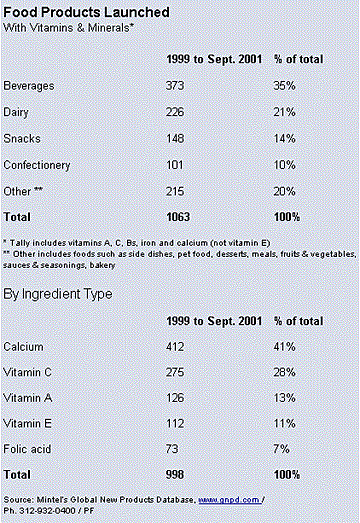Vitamins and Minerals: Value-Adding with Vitamins and Minerals

The popularity of specific vitamins and minerals will increase as scientists and the public better understand their role beyond preventing basic nutritional deficiencies. This is not to say all will be smooth sailing, however.
According to a recent Mintel report, the U.S. vitamin and mineral market increased 10-25% per year in the early and mid-1990s, but recently has slowed, partly due to media attention focusing on studies disproving various health claims made by vitamin and mineral manufacturers. Consumer research by Mintel notes that about half of U.S. consumers say they find the information about vitamins confusing. This dovetails well with a Prevention/ FMI survey taken several years ago which found that 73% of consumers felt there was too much conflicting information about which foods are healthy and which are not.
This hesitation likely impacted vitamin and mineral dietary supplement sales. Mintel reports that multi-vitamin sales were $1.4 billion in 1999, single-letter vitamin sales were $1.3 billion, and mineral sales were $800 million. Increasingly, consumers appear most interested in products combining several vitamins, minerals or herbs into pills offering a specific benefit, such as eye health. For the 12 months ending August 19, 2001, IRI (Information Resources Inc.) reports that single-letter vitamins were down 12.4%, while volumes for broad-based antioxidants were up 30.7%. The same trend holds in minerals, where single-compound sales were down 1.8%, but “multi-minerals” were up 19%.
“By purchasing a compound product, the consumer is leaving the choice of individual components and appropriate doses to the manufacturer. The interest in multi-purpose, multi-benefit products also drives support toward food as a nutrient source,” says Amy Stockwell, principle, Analytech Associates, Decatur, Ill.
Separate Identities
The image and popularity of individual items within this category will vary, depending on factors such as new clinical research, the actual need for fortification and the media's coverage of positive and negative effects.Mintel's Global New Product Database (GNPD) shows that, in recent years, calcium and vitamin C have been the most popular food fortifiers; however, the highest growth rates have been for vitamins A, C, and iron. Here is a look at some specific fortifiers.
Calcium: The Center for Disease Control reports average daily intakes of calcium at 976mg for men and 744mg for women, both well below recommended levels of 1,000 to 1,300mg per day. This “under-consumption” of calcium, coupled with research on this mineral's multiple benefits (which are supported by strong science), means calcium is likely to remain one of the most popular fortifiers.

B Vitamins. There has been a significant level of new product activity regarding items fortified with folic acid, which has been driven (in part) by positive research. For example, the 1998 Nurses' Health Study of 80,000 women and two articles in the November 29, 2001 issue of the New England Journal, support the roles vitamins B6, B12 and folic acid play in reducing the risk of heart disease. The ability of niacin (B3) to lower cholesterol is well-known. This helped drive supplement sales of niacin in 1999, which was up 57% over the previous year, according to The Hartman Group, Seattle. Key food segments for fortification are beverages, breakfast cereals and snacks (particularly the granola/cereal bars).

Generally, however, both the media and research studies continue to provide strong support for both the vitamin itself and the need for supplementation in even well-balanced diets. Along with reducing the risk of heart disease, vitamin E, an antioxidant, may also reduce risks of certain cancers, Alzheimer's disease, macular degeneration and cataracts.
Mostly Thumbs Up
A few clouds on the horizon exist for vitamins and minerals. The press may question not only the usefulness of vitamins, but also their overuse. Recently, consumerlab.com reported that most all vitamin B supplements meet or exceed their claimed potency, but when consumed in excess, negative health risks result.Similarly, a January 2, 2002 article published in JAMA, reported that women consuming an excess of 6,600 international units (IU) per day of vitamin A from food and/or dietary supplements may be at a higher risk of osteoporosis. The research found vitamin A derived from beta carotene had no effect on bone health.
However, as with many nutrients, aging demographics will continue to help drive this category. For example, an article by Dr. Kevin High, published in the December 1, 2001 issue of Clinical Infectious Diseases, reviewed clinical studies and concluded that persons over 65 years old can benefit from a daily multivitamin and mineral supplement.
Americans' propensity toward a hectic lifestyle and nutritional quick fixes bodes well for this category.
A thank-you goes to Mintel Consumer Intelligence: U.S. Ingredients Report upon which some this article is based. For more information, contact Mintel at 312-943-5250; www.consumer.mintel.com
Sidebar: Great Expectations
Some 13% of U.S. households are core participants while 62% are mid-level participants in a wellness lifestyle. The market for wellness products should be vast.The functional food industry will grow as large manufacturers market the benefits of products such as orange juice with calcium, or other standard beverages fortified with dietary supplements.
— Harvey Hartman, The Hartman Group, info@hartman-group.com
Beverages, cereal/granola bars, breakfast cereals and yogurts will be likely vehicles for heavy-duty fortification because these are consistent with consumers' expectations of healthy/fortified products.
— Lynn Dornblaser, Editorial Director, GNPD, lynnd@mintel.com
Links
Looking for a reprint of this article?
From high-res PDFs to custom plaques, order your copy today!


